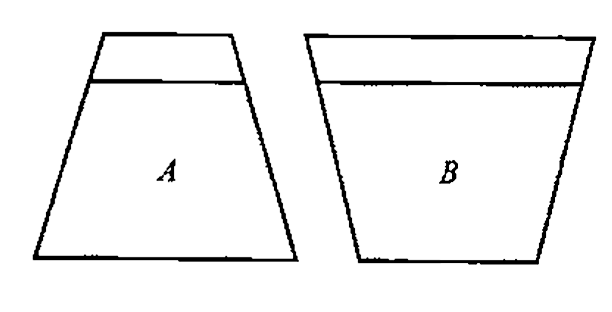Three vessels A,B,and C of different shapes contain a water upto the same height as shown in the figure .PA,PB ,and PC be the pressure exerted by the water at the bottom of the vessels A ,B and C respectively . Then

PA>PB>PC
PB>PC>PA
PC>PB>PA
PA=PB=PC
The correct Answer is:D
Pressure=hρg
Pressure at the bottom is idenpendent of the area of the base of vessel. It depends on the height of water upto vessels, level is filled with water. As in all the three vessels, level of water are the same, therefore pressure at the bottom in all the vessels is also the same.
Hence, PA=PB=PC
Topper's Solved these Questions
- MECHANICAL PROPERTIES OF FLUIDSBook:NCERT FINGERTIPSChapter:MECHANICAL PROPERTIES OF FLUIDSExercise:Streamline Flow
Explore 7 Videos
- MECHANICAL PROPERTIES OF FLUIDSBook:NCERT FINGERTIPSChapter:MECHANICAL PROPERTIES OF FLUIDSExercise:Bernoulli'S Principle
Explore 15 Videos
- LAWS OF MOTIONBook:NCERT FINGERTIPSChapter:LAWS OF MOTIONExercise:Assertion And Reason
Explore 15 Videos
- MECHANICAL PROPERTIES OF SOLIDSBook:NCERT FINGERTIPSChapter:MECHANICAL PROPERTIES OF SOLIDSExercise:Assertion And Reason
Explore 15 Videos
Similar Questions
Three vessels containing same liquid, upto the same height h, then pressure at the bottom is (A1>A2>A3)

View SolutionWhen two liquids A and B of equal weight are filled inside two identical containers, the height of the liquid Column A is greater than the height of the liquid Column B. If PAandPB are the pressures exerted by A and B at the bottom of the containers, respectively, and dA,dB are the densities of A and B, respectively, which of the following statements is true ?
View Solution
Knowledge Check
Three vessels A, B and C of different shapes contain water upto the same height in the figure. PA,PBandPC be the pressure exerted by the water at the bottom of the vessels A, B and C respectively. Then
 APA>PB>PCBPB>PC>PACPC>PB>PADPA=PB=PC
APA>PB>PCBPB>PC>PACPC>PB>PADPA=PB=PCTwo vessels A and B of different shapes have the same base area and are filled with water up to the same height h (see figure). The force exerted by water on the base is FA for vessel A and FB for vessel B. The respective weights of the water filled in vessels are WA and WB. Then
 AFA>FB,WA>WBBFA=FB,WA>WBCFA=FB,WA<WBDFA>FB,WA=WB
AFA>FB,WA>WBBFA=FB,WA>WBCFA=FB,WA<WBDFA>FB,WA=WBTwo vessels A and B of different shapes have the same base area and are filled with water up to the same height h (see figure). The force exerted by water on the base is FA for vessel A and FB for vessel B. The respective weights of the water filled in vessels are WA and WB. Then
 AFA>FB,WA>WBBFA=FB,WA>WBCFA≡FB,WA<WBDFA>FB,WA=WB
AFA>FB,WA>WBBFA=FB,WA>WBCFA≡FB,WA<WBDFA>FB,WA=WB
Two vessels A and B of cross sections as shown contain a liquid up to the same height. As the temperature rises, the liquid pressure at the bottom (neglecting expansion of the vessels ) will :

View SolutionFour vessels A, B, C and D have different shapes and hold different amount of water. Which of the following is correct.

View SolutionThree identical vessels A,B and C contain same quantity of liquid. In each vessel balls of different densities but same masses are placed. In vessel A, the ball is partly submerged, in vessel B, the ball is completely submerged but floating and in vessel C, the ball has sunk to the base. If FA,FB and FC are the total forces acting on the base of vessels A,B and C, respectively, then

View SolutionAn object of uniform density is allowed to float in water kept in a beaker. The object has triangular cross-section as shown in the figure. If the water pressure measured at the three points A, B and C below the object are PA,PB and PC respectively. Then

View SolutionA wooden object floats in water kept in as beaker. The object is near a side of the beaker figure. Let P1,P2,P3 be the pressure at the three points A,B and C of the bottom as shown in the figure.

View Solution

